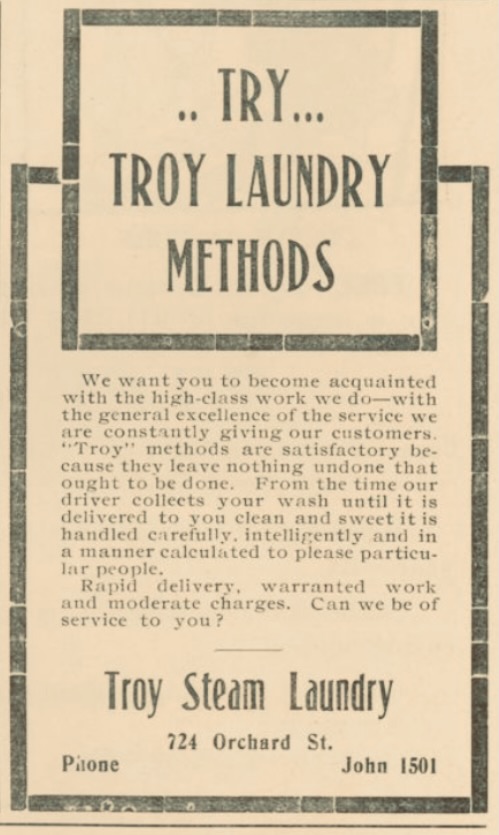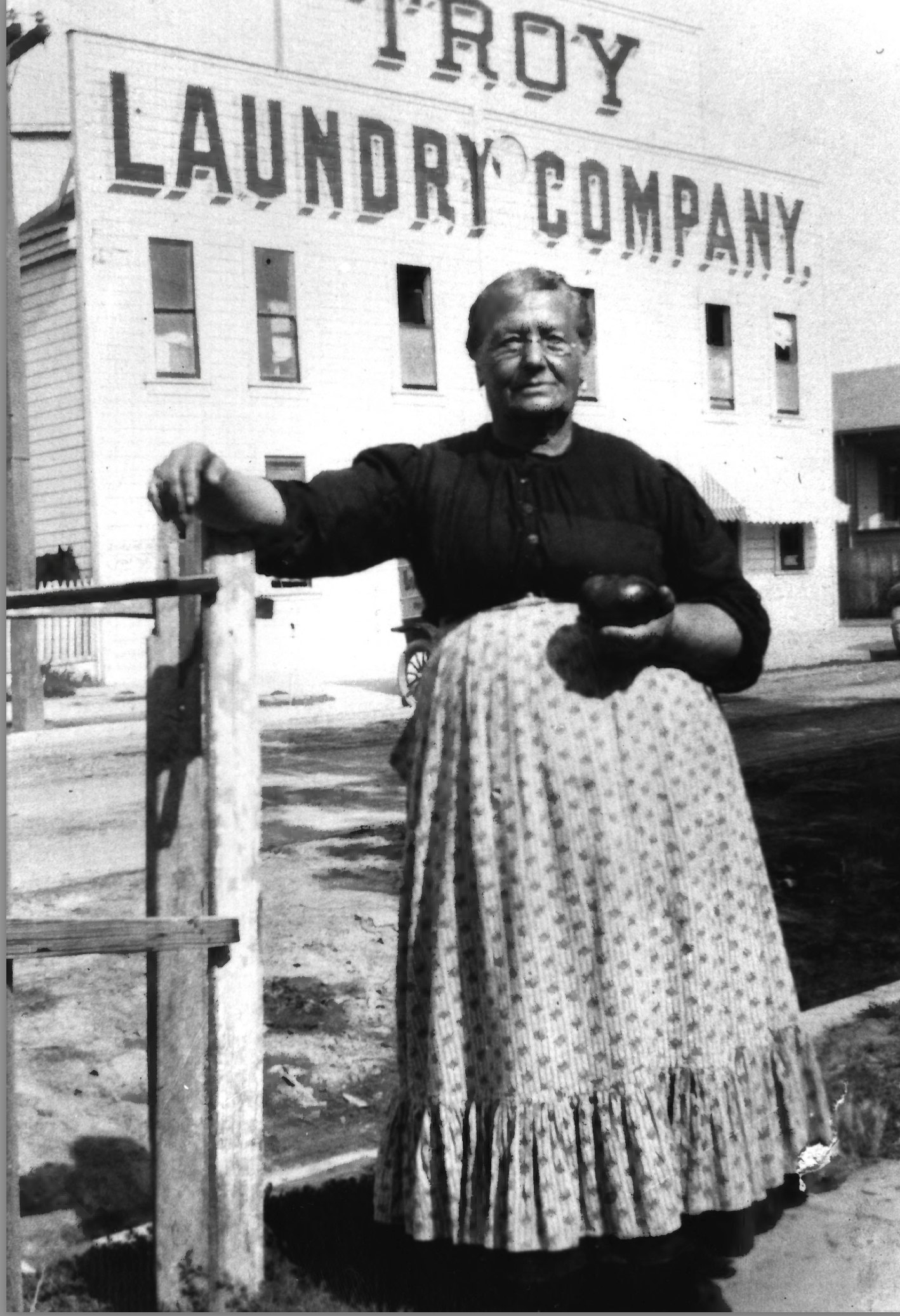Troy Laundry Building (San Jose, California) on:
[Wikipedia]
[Google]
[Amazon]
The Troy Laundry, also known as the Troy Steam Laundry, established in 1895 by Charles Larnell Southgate, was a historic

 Charles Larnell Southgate (1862-1939) established Troy Laundry and served as its owner. Originally from Brooklyn, New York, he relocated to San Jose in 1895 to start the laundry business. The original name of the company was Troy Steam Laundry and was located at 724 Orchard Street in 1896 (renamed Almaden Avenue). In 1895, Southgate partnered with Stiner G. Stinerson. The laundry underwent expansion in 1922-23, overseen by carpenter, Mike Solimine. Southgate remarried in 1922. He had two sons from his first wife. Following Stinerson's death in 1936, Southgate died in 1939. In 1946, ownership passed to the Dalesandro family. Eva and Frank Dalesandro managed the laundry until 1966 when Norman Little acquired it in an estate sale. He operated the busienss until its sale to Robert E. Fazo in 1979.
The Troy Steam Laundry competed with several other laundries in San Jose, such as the Red Star, Temple, Consolidated, Diamond, Individual, and R&W Wet Wash. Its clientele included prominent establishments in San Jose, such as the
Charles Larnell Southgate (1862-1939) established Troy Laundry and served as its owner. Originally from Brooklyn, New York, he relocated to San Jose in 1895 to start the laundry business. The original name of the company was Troy Steam Laundry and was located at 724 Orchard Street in 1896 (renamed Almaden Avenue). In 1895, Southgate partnered with Stiner G. Stinerson. The laundry underwent expansion in 1922-23, overseen by carpenter, Mike Solimine. Southgate remarried in 1922. He had two sons from his first wife. Following Stinerson's death in 1936, Southgate died in 1939. In 1946, ownership passed to the Dalesandro family. Eva and Frank Dalesandro managed the laundry until 1966 when Norman Little acquired it in an estate sale. He operated the busienss until its sale to Robert E. Fazo in 1979.
The Troy Steam Laundry competed with several other laundries in San Jose, such as the Red Star, Temple, Consolidated, Diamond, Individual, and R&W Wet Wash. Its clientele included prominent establishments in San Jose, such as the
Guide to the Steinerson Family Photograph Album
{{DEFAULTSORT:Troy Laundry Laundry History of Santa Clara County, California Buildings and structures in San Jose, California National Register of Historic Places in Santa Clara County, California
laundry
Laundry refers to the washing of clothing and other textiles, and, more broadly, their drying and ironing as well. Laundry has been part of history since humans began to wear clothes, so the methods by which different cultures have dealt with t ...
located on 722 Almaden Avenue in San Jose, California. The Troy Laundry operated at this site from 1896 to 1979, serving as an example of 19th-century false front
False or falsehood may refer to:
*False (logic), the negation of truth in classical logic
* Lie or falsehood, a type of deception in the form of an untruthful statement
*false (Unix), a Unix command
* ''False'' (album), a 1992 album by Gorefest
*M ...
wooden industrial architecture. The site is now occupied by the Troy Apartments. The Troy Laundry was recognized and officially listed on the National Register of Historic Places on January 28, 1982.
History

 Charles Larnell Southgate (1862-1939) established Troy Laundry and served as its owner. Originally from Brooklyn, New York, he relocated to San Jose in 1895 to start the laundry business. The original name of the company was Troy Steam Laundry and was located at 724 Orchard Street in 1896 (renamed Almaden Avenue). In 1895, Southgate partnered with Stiner G. Stinerson. The laundry underwent expansion in 1922-23, overseen by carpenter, Mike Solimine. Southgate remarried in 1922. He had two sons from his first wife. Following Stinerson's death in 1936, Southgate died in 1939. In 1946, ownership passed to the Dalesandro family. Eva and Frank Dalesandro managed the laundry until 1966 when Norman Little acquired it in an estate sale. He operated the busienss until its sale to Robert E. Fazo in 1979.
The Troy Steam Laundry competed with several other laundries in San Jose, such as the Red Star, Temple, Consolidated, Diamond, Individual, and R&W Wet Wash. Its clientele included prominent establishments in San Jose, such as the
Charles Larnell Southgate (1862-1939) established Troy Laundry and served as its owner. Originally from Brooklyn, New York, he relocated to San Jose in 1895 to start the laundry business. The original name of the company was Troy Steam Laundry and was located at 724 Orchard Street in 1896 (renamed Almaden Avenue). In 1895, Southgate partnered with Stiner G. Stinerson. The laundry underwent expansion in 1922-23, overseen by carpenter, Mike Solimine. Southgate remarried in 1922. He had two sons from his first wife. Following Stinerson's death in 1936, Southgate died in 1939. In 1946, ownership passed to the Dalesandro family. Eva and Frank Dalesandro managed the laundry until 1966 when Norman Little acquired it in an estate sale. He operated the busienss until its sale to Robert E. Fazo in 1979.
The Troy Steam Laundry competed with several other laundries in San Jose, such as the Red Star, Temple, Consolidated, Diamond, Individual, and R&W Wet Wash. Its clientele included prominent establishments in San Jose, such as the Hotel Montgomery
The Four Points by Sheraton San Jose Downtown or Hotel Montgomery is a historic hotel in Downtown San Jose, California.
History
In an effort to preserve the hotel, and to accommodate the 13-story, 264 room expansion of the Fairmont San Jose Hot ...
, Vendom Hotel, Costa Hotel, San Jose State University, numerous restaurants, and sporting houses. Laundry services were provided to distant locations, including the Lick Observatory
The Lick Observatory is an astronomical observatory owned and operated by the University of California. It is on the summit of Mount Hamilton, in the Diablo Range just east of San Jose, California, United States. The observatory is managed by th ...
, New Almaden Mines, Watsonville
Watsonville is a city in Santa Cruz County, California, located in the Monterey Bay Area of the Central Coast of California. The population was 52,590 according to the 2020 census. Predominantly Latino and Democratic, Watsonville is a self- ...
, Gilroy, and Stanford University
Stanford University, officially Leland Stanford Junior University, is a private research university in Stanford, California. The campus occupies , among the largest in the United States, and enrolls over 17,000 students. Stanford is consider ...
. Initially, laundry was transported by horse-drawn wagons, and later by locally designed trucks from the Southern Pacific Depot in San Jose.
By 1995 the Troy Laundry had been demolished and replaced by Troy Apartments.
Design
The Troy Laundry exemplified late 19th century Western false front architecture, featuring one and two-story wood frame construction spanning an area of . Additions were made in 1922-23, including the replacement of the boiler. The exterior had horizontal wood siding with a gabled roof covered in wood shingles. Windows were double hung with one fixed window in theclerestory
In architecture, a clerestory ( ; , also clearstory, clearstorey, or overstorey) is a high section of wall that contains windows above eye level. Its purpose is to admit light, fresh air, or both.
Historically, ''clerestory'' denoted an upper l ...
to provide light. The false front rose in steps to obscure the gabled roofline and accommodate signage. A one-story section extended to the rear, accommodating the boiler and other facilities.
Post and beam construction was utilized in the laundry work area to create a spacious, open layout like what is commonly seen in today's industrial and manufacturing buildings. A skylight was installed to offer natural light to the steam engine, situated east of the clerestory space. Adjacent to the steam engine, the boiler was positioned and partitioned by a pair of brick walls. This double brick wall extended around the boiler, creating a distinct boiler room.
Historical status
The Troy Laundry was placed on the National Register of Historic Places on January 28, 1982. The Troy Laundry holds historical significance as a landmark commercial establishment, operating in San Jose from 1896 to 1979, and representing a 19th-century false-front wooden industrial architecture.See also
* National Register of Historic Places listings in Santa Clara County, CaliforniaReferences
External links
Guide to the Steinerson Family Photograph Album
{{DEFAULTSORT:Troy Laundry Laundry History of Santa Clara County, California Buildings and structures in San Jose, California National Register of Historic Places in Santa Clara County, California